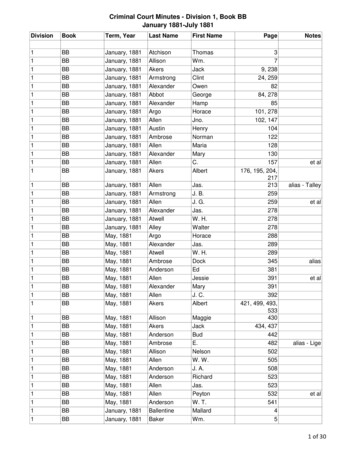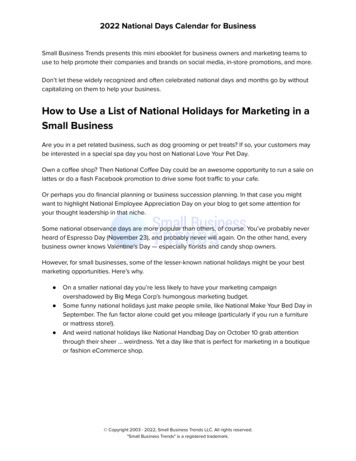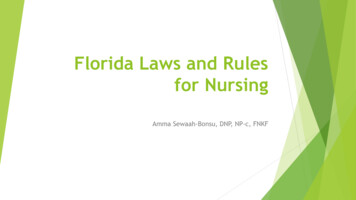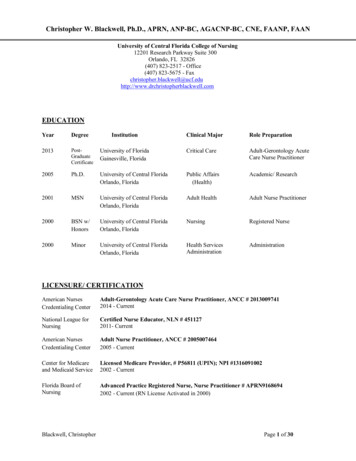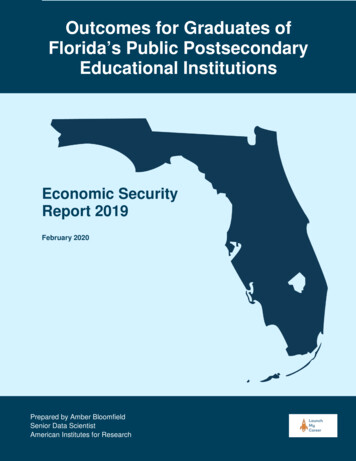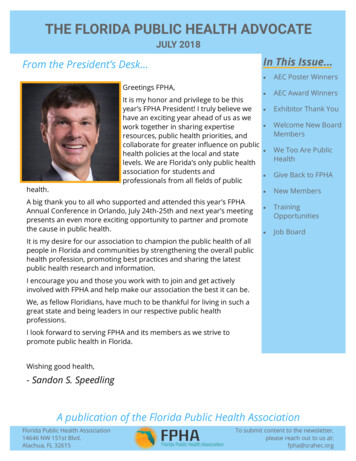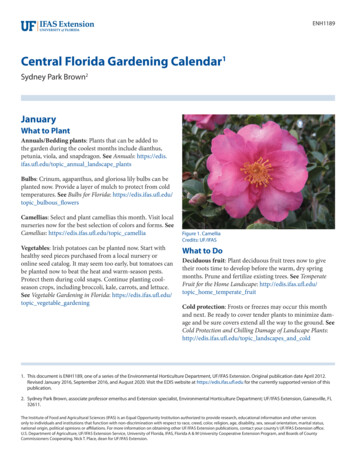
Transcription
ENH1189Central Florida Gardening Calendar1Sydney Park Brown2JanuaryWhat to PlantAnnuals/Bedding plants: Plants that can be added tothe garden during the coolest months include dianthus,petunia, viola, and snapdragon. See Annuals: https://edis.ifas.ufl.edu/topic annual landscape plantsBulbs: Crinum, agapanthus, and gloriosa lily bulbs can beplanted now. Provide a layer of mulch to protect from coldtemperatures. See Bulbs for Florida: https://edis.ifas.ufl.edu/topic bulbous flowersCamellias: Select and plant camellias this month. Visit localnurseries now for the best selection of colors and forms. SeeCamellias: https://edis.ifas.ufl.edu/topic camelliaVegetables: Irish potatoes can be planted now. Start withhealthy seed pieces purchased from a local nursery oronline seed catalog. It may seem too early, but tomatoes canbe planted now to beat the heat and warm-season pests.Protect them during cold snaps. Continue planting coolseason crops, including broccoli, kale, carrots, and lettuce.See Vegetable Gardening in Florida: https://edis.ifas.ufl.edu/topic vegetable gardeningFigure 1. CamelliaCredits: UF/IFASWhat to DoDeciduous fruit: Plant deciduous fruit trees now to givetheir roots time to develop before the warm, dry springmonths. Prune and fertilize existing trees. See TemperateFruit for the Home Landscape: http://edis.ifas.ufl.edu/topic home temperate fruitCold protection: Frosts or freezes may occur this monthand next. Be ready to cover tender plants to minimize damage and be sure covers extend all the way to the ground. SeeCold Protection and Chilling Damage of Landscape Plants:http://edis.ifas.ufl.edu/topic landscapes and cold1. This document is ENH1189, one of a series of the Environmental Horticulture Department, UF/IFAS Extension. Original publication date April 2012.Revised January 2016, September 2016, and August 2020. Visit the EDIS website at https://edis.ifas.ufl.edu for the currently supported version of thispublication.2. Sydney Park Brown, associate professor emeritus and Extension specialist, Environmental Horticulture Department; UF/IFAS Extension, Gainesville, FL32611.The Institute of Food and Agricultural Sciences (IFAS) is an Equal Opportunity Institution authorized to provide research, educational information and other servicesonly to individuals and institutions that function with non-discrimination with respect to race, creed, color, religion, age, disability, sex, sexual orientation, marital status,national origin, political opinions or affiliations. For more information on obtaining other UF/IFAS Extension publications, contact your county’s UF/IFAS Extension office.U.S. Department of Agriculture, UF/IFAS Extension Service, University of Florida, IFAS, Florida A & M University Cooperative Extension Program, and Boards of CountyCommissioners Cooperating. Nick T. Place, dean for UF/IFAS Extension.
Irrigation: Irrigate lawns and landscape plants minimally.This is their dormant season. See Landscape Irrigation:http://edis.ifas.ufl.edu/topic landscape irrigationShrubs and trees: Prune non-spring flowering shrubs andtrees this month to improve form. See Pruning LandscapeTrees and Shrubs: http://edis.ifas.ufl.edu/topic tree pruningArbor Day: Celebrate Florida Arbor Day (the thirdFriday of January) by planting a tree in your yard or community. See Arbor Day in Florida: http://edis.ifas.ufl.edu/topic arbor dayWhat to DoPalms: Give cold-damaged palms proper care to encourage their recovery. See Cold Protection and ChillingDamage of Landscape Plants: http://edis.ifas.ufl.edu/topic landscapes and coldRoses: Prune roses this month to remove dead and damaged canes (stems) and to improve the overall form. Afterpruning, fertilize and apply a fresh layer of mulch. Blooming will begin 8–9 weeks after pruning. See Roses: http://edis.ifas.ufl.edu/topic roseCrapemyrtle: Remove seed pods, crossing branches, andsmall twiggy growth to improve the appearance and formof the plant, if desired. Hard pruning is not required. SeeCrapemyrtle: http://edis.ifas.ufl.edu/topic crapemyrtlePests: Apply horticultural oil to control scale insects. Readand follow the label instructions because oil can damageplants when misapplied. See Landscape Pest Management:http://edis.ifas.ufl.edu/topic landscape pestsTrees: Prepare for hurricane season by checking trees fordamaged or weak branches and pruning if needed. Hire anISA-certified arborist. See International Society of Arboriculture: http://isa-arbor.com/ and Pruning Landscape Treesand Shrubs: https://edis.ifas.ufl.edu/topic tree pruningFebruaryWhat to PlantAnnuals/Bedding plants: Plants that perform betterin the cooler months include petunia, pansy, verbena,dianthus, strawflower, and lobelia. Protect from frosts andfreezing temperatures. See Annuals: http://edis.ifas.ufl.edu/topic annual landscape plantsBulbs: Many bulbs can be planted now. Provide adequatewater for establishment and protect from cold weather withmulch. Some examples include Amazon lily, crinum, andagapanthus. See Bulbs for Florida: http://edis.ifas.ufl.edu/topic bulbous flowersAzaleas: With azaleas in full bloom this month, now is agreat time to select varieties to add to the landscape. SeeAzalea: http://edis.ifas.ufl.edu/topic azaleaVegetables: Numerous warm- and cool-season vegetablescan be planted this month. Protect cold-tender veggies like tomatoes if a frost or freeze is predicted. SeeVegetable Gardening in Florida: http://edis.ifas.ufl.edu/topic vegetable gardeningCentral Florida Gardening CalendarFigure 2. RoseCredits: UF/IFASShrubs: Fertilize shrubs by spreading fertilizer evenlyover the soil surface and watering it in. Follow with afresh layer of mulch to conserve moisture and reduceweeds. See Landscape Fertilization: http://edis.ifas.ufl.edu/topic landscape fertilizationLawn: Apply a preemergence weed killer (not a “weedand feed”) to lawns this month to prevent germination ofwarm-season weed seeds. Apply when temperatures rise to65 F for 4–5 days. Timing is important for good control.See Lawn Weeds: http://edis.ifas.ufl.edu/topic lawn weedsCitrus and other fruit trees: Fertilize; the amount offertilizer and the frequency of applications depend on theage of the tree. See Home Citrus Culture: http://edis.ifas.ufl.edu/topic citrus home citrus culture and TemperateFruit for the Home Landscape: http://edis.ifas.ufl.edu/topic home temperate fruitTrees: Don’t wait until hurricane season to check yourtrees. Hire an ISA-certified arborist to do an inspection.See International Society of Arboriculture: http://isa-arbor.com/ and Pruning Landscape Trees and Shrubs: http://edis.ifas.ufl.edu/topic tree pruning2
MarchWhat to PlantAnnuals: Replace declining winter annuals with varietiessuch as angelonia, gazania, impatiens, and salvia that willprovide color now and into the summer months. See Annuals: http://edis.ifas.ufl.edu/topic annual landscape plantsBulbs: Plant caladiums for a showy tropical display allsummer. See Bulbs for Florida: http://edis.ifas.ufl.edu/topic bulbous flowersIrrigation: Check sprinkler systems for efficient wateruse. See Landscape Irrigation: http://edis.ifas.ufl.edu/topic landscape irrigationAprilWhat to PlantAnnuals: New varieties of coleus and impatiens do well insun or shade and provide vivid color for months. See Annuals: http://edis.ifas.ufl.edu/topic annual landscape plantsBulbs: Planting early-, mid-, and late-blooming varietiesof daylily ensures months of color from these lowmaintenance plants. See Bulbs for Florida: http://edis.ifas.ufl.edu/topic bulbous flowers and Daylilies: http://edis.ifas.ufl.edu/topic dayliliesHerbs: Try the wide assortment of basils available today,but select varieties that are resistant to downy mildewdisease. See Herbs: http://edis.ifas.ufl.edu/topic herbsVegetables: Continue planting warm-season crops, suchas beans, sweet corn, and squash. Mulch well to preventweeds and provide water if the weather has been dry. SeeVegetable Gardening in Florida: http://edis.ifas.ufl.edu/topic vegetable gardeningFigure 3. CaladiumCredits: Tyler Jones, UF/IFASHerbs: In addition to their culinary value, many herbs areornamental and attract butterflies to the garden. See Herbs:http://edis.ifas.ufl.edu/topic herbsVegetables: Warm-season crops, such as beans,peppers, squash, and others can be planted now. SeeVegetable Gardening in Florida: http://edis.ifas.ufl.edu/topic vegetable gardeningWhat to DoAzaleas: Prune azaleas just after plants finish blooming toshape or produce a fuller plant. See Azalea: http://edis.ifas.ufl.edu/topic azaleaShrubs and trees: Prune when new growth begins after theend of the dormant season. To guard next season’s blooms,begin pruning after the last flowers fade but before the newbuds set. See Pruning Landscape Trees and Shrubs: http://edis.ifas.ufl.edu/topic tree pruningPalms and shrubs: Fertilize palms, azaleas, camellias, andother ornamental shrubs if needed. See Landscape Fertilization: http://edis.ifas.ufl.edu/topic landscape fertilizationCentral Florida Gardening CalendarWhat to DoPlant for butterflies: Plant flowers of different colors,shapes, sizes, and blooming seasons to provide nectar foradult butterflies and provide host plants for their caterpillars. See Butterfly Gardening: https://edis.ifas.ufl.edu/topic butterfly gardeningPests: Monitor landscape plants weekly for aphids on tender new growth. See Landscape Insect and Mite Pests: http://edis.ifas.ufl.edu/topic landscape insect pests by typeand Landscape Pest Management: http://edis.ifas.ufl.edu/topic landscape pestsBeneficials: Identify and conserve beneficial insects. Someinsects should be encouraged in your yard! See BeneficialInsects: http://edis.ifas.ufl.edu/topic beneficial insectsFlowering plants: Check for thrips if leaves and/or flowersof gardenias and roses are damaged. See Landscape PestManagement: http://edis.ifas.ufl.edu/topic landscape pestsPerennials and bulbs: Divide clumps of bulbs, ornamentalgrasses, or herbaceous perennials to expand or rejuvenategarden beds or to pass along to friends. See Bulbs forFlorida: http://edis.ifas.ufl.edu/topic bulbous flowers3
and Perennial Landscape Plants: http://edis.ifas.ufl.edu/topic perennialsMayWhat to PlantAnnuals: Plants that can take summer heat include salvia,torenia, coleus, vinca, and ornamental pepper. See Annuals:http://edis.ifas.ufl.edu/topic annual landscape plantsBulbs: Some lilies do better when their roots are crowded.Try planting Amazon, Aztec, and Clivia lilies in containers;they bloom better when their roots are confined. See Bulbsfor Florida: http://edis.ifas.ufl.edu/topic bulbous flowersHerbs: Plant heat-loving herbs, including basil, Mexicantarragon, and culantro. See Herbs: http://edis.ifas.ufl.edu/topic herbsFigure 4. Lady beetleCredits: UF/IFASLawn insects: Rule out cultural problems, such as lackof water, that resemble insect damage before applying apesticide. See Insect Pests in Florida Lawns: https://edis.ifas.ufl.edu/topic lawn insect pestsLawns: Apply fertilizer after new growth has started, whichis usually early April in north-central and central Florida.Choose a fertilizer (not a “weed and feed”) with little orno phosphorus unless a soil test indicates the need for it.A fertilizer with controlled-release nitrogen yields longerlasting results. See Lawn Fertilizer: http://edis.ifas.ufl.edu/topic lawn fertilizationShrubs: Choose from a wide variety of shrubs to add tothe landscape now. Remember Right Plant/Right Placeand match the mature size with the location. See Shrubs:http://edis.ifas.ufl.edu/topic shrubs and The FloridaFriendly Landscaping Guide to Plant Selection & LandscapeDesign: https://ffl.ifas.ufl.edu/pdf/FYN Plant Selection Guide 2015.pdfMulch: Add mulch to minimize weeds and conservemoisture during dry weather. Organic mulches add nutrients to the soil. See Landscape Mulches: http://edis.ifas.ufl.edu/topic mulchVegetables: Southern favorites to plant now areokra, southern peas, and sweet potato. Heat-toleranttropicals to consider are boniato and calabaza. SeeVegetable Gardening in Florida: http://edis.ifas.ufl.edu/topic vegetable gardeningWhat to DoPests: Watch for thrips, scale, and mites on ornamentalplants because they become more active in warm weather.See Landscape Pest Management: http://edis.ifas.ufl.edu/topic landscape pestsGardenias: Distinguish between the normal yellowing ofolder leaves and the yellowing of new growth, which usuallyindicates a micronutrient deficiency. See Gardenias at aGlance: http://edis.ifas.ufl.edu/ep338Oleanders: Inspect chewed or ragged leaves for oleandercaterpillars at work. See Oleander Pest Management: http://edis.ifas.ufl.edu/topic oleander ipmLawns: Watch for damage from chinch bugs in St.Augustinegrass and begin scouting for newly hatched molecrickets in bahiagrass lawns. See Insect Pests in FloridaLawns: https://edis.ifas.ufl.edu/topic lawn insect pests.May is usually a dry month; do not mistake irrigationproblems with a pest infestation. See Lawns and Drought:http://edis.ifas.ufl.edu/topic lawns and droughtLawns: Prevent or minimize disease by following propercultural practices. See Turf Diseases: http://edis.ifas.ufl.edu/topic turf diseasesTomatoes: Watch for pests, disease, and nutritional disorders on tomato plants. See Home Tomato Gardening: http://edis.ifas.ufl.edu/topic tomato gardeningCentral Florida Gardening Calendar4
Propagation: Produce more plants by air layering, grafting,division, or cuttings. See Seeds and Propagation (Land andGarden): http://edis.ifas.ufl.edu/topic garden propagationFigure 5. TomatoCredits: Sally Lanigan, UF/IFASJuneWhat to PlantAnnuals: Annuals that can take full sun during the increasingly hot summer months include celosia, portulaca, vinca,and some coleus. See Annuals: http://edis.ifas.ufl.edu/topic annual landscape plantsPalms: Summer’s warm, rainy months are the perfect timeto plant palms. Make sure not to cover the trunk with soil.See Palms: http://edis.ifas.ufl.edu/topic palmsHerbs: Plant heat-loving herbs, including basil, Mexicantarragon, and culantro. Pinch back regularly to preventflowering and enhance branching. See Herbs: http://edis.ifas.ufl.edu/topic herbsVegetables: Plant okra, southern pea, calabaza,Malabar spinach, sweet potato, chayote, and boniato. SeeVegetable Gardening in Florida: http://edis.ifas.ufl.edu/topic vegetable gardeningWhat to DoPests: Monitor the landscape and garden weekly for harmful insects. Knowing which insects attack a plant can aid inidentification and treatment. See Landscape Pest Management: http://edis.ifas.ufl.edu/topic landscape pestsIrrigation: Watch for drought stress and water as neededif rainfall has been spotty. Focus on new plantings andfollow watering restrictions. When rains begin, shutdown the irrigation system or install a rain shut offdevice. See Landscape Irrigation: http://edis.ifas.ufl.edu/topic landscape irrigationCentral Florida Gardening CalendarFigure 6. HibiscusCredits: UF/IFASPalms and cycads: Watch for nutrient deficiencies or otherproblems and use an appropriate treatment. Keep lawnfertilizers away from the root zone. See Palm Care: http://edis.ifas.ufl.edu/topic palm carePruning: Lightly prune summer-flowering shrubs, likehibiscus, oleander, and crapemyrtle, during the warmermonths because they bloom on new growth. Azaleas canstill be pruned until the middle of next month withoutharming next spring’s buds. See Pruning Landscape Treesand Shrubs: http://edis.ifas.ufl.edu/topic tree pruningFertilizer bans: Some municipalities in central Florida prohibit the application of fertilizer to lawns and/or landscapeplants during the summer rainy season (June–September).Does such an ordinance exist in your area? nances.pdf?v 20190606Soil solarization: Clean up your vegetable garden and solarize the soil to reduce nematodes and other pests. See SoilSolarization: http://edis.ifas.ufl.edu/topic soil solarizationJulyWhat to PlantAnnuals/Bedding plants: Summer annuals to plantnow include celosia, coleus, torenia, and ornamental pepper. See Annuals: http://edis.ifas.ufl.edu/topic annual landscape plantsBulbs: Butterfly lily and gladiolus can be planted during themiddle of summer. See Bulbs for Florida: http://edis.ifas.ufl.edu/topic bulbous flowers5
Herbs: While summer is too hot to start herbs from seeds,many do well if started from small plants. See Herbs: http://edis.ifas.ufl.edu/topic herbsPalms: Continue planting palms while the rainy season is infull swing. Support large palms with braces for 6–8 monthsafter planting. Nails should not be driven directly into apalm trunk. See Palms: http://edis.ifas.ufl.edu/topic palmsVegetables: Start your Halloween pumpkins early thismonth, give them room to grow, and watch out fordiseases. Okra and Southern peas can also be planted. SeeVegetable Gardening in Florida: http://edis.ifas.ufl.edu/topic vegetable gardeningWhat to DoLawns: Determine the cause of any lawn problems beforetaking action. If an insect is the culprit, treat only theaffected area. Rule out disease or sprinkler malfunction. See Garden Pest Insects: http://edis.ifas.ufl.edu/topic garden pest insectsFertilizer bans: Some municipalities in central Florida prohibit the application of fertilizer to lawns and/or landscapeplants during the summer rainy season (June–September).Does such an ordinance exist in your area? nances.pdf?v 20190606Irrigation: Install an inexpensive rain shutoff device tosave money by overriding an irrigation system when itrains. If one is already installed, check that it is operatingproperly. See Landscape Irrigation: http://edis.ifas.ufl.edu/topic landscape irrigationPests on ornamental plants: Inspect the leaves of azaleasfor damage from lacebugs. Look for tiny white dots onthe upper surface and small black oil spots of excreta onthe underside. Spray forcefully with water to help controlthis pest. See Landscape Lace Bug Pests (Azalea Lace Bug)http://edis.ifas.ufl.edu/topic landscape lace bug pestsCitrus: Check citrus trees for damage to fruit or leavesand take action to minimize the effect of insects and/ordisease on developing fruit and the overall health of thetree. See Home Citrus Culture: http://edis.ifas.ufl.edu/topic citrus home citrus cultureAugustWhat to PlantAnnuals/Bedding plants: The hottest days of summerlimit planting now to heat-tolerant annuals, such as coleus,kalanchoe, and vinca. See Annuals: http://edis.ifas.ufl.edu/topic annual landscape plantsVegetable garden: Use summer heat to solarize thevegetable garden for fall planting. It takes at least 6 weeksto kill weeds, disease, and nematodes, so start now. See SoilSolarization: http://edis.ifas.ufl.edu/topic soil solarizationAzaleas: Prune no later than mid-July to protect developingbuds for next spring’s bloom. See Azalea: http://edis.ifas.ufl.edu/topic azaleaFigure 8. VincaCredits: Tyler Jones, UF/IFASBulbs: Aztec lily, butterfly lily, walking iris, and spiderlily can be planted any time of the year, even late summer. See Bulbs for Florida: http://edis.ifas.ufl.edu/topic bulbous flowersHerbs: Herbs that are started from plants (not seeds)include bay laurel, ginger, Mexican tarragon, and rosemary.See Herbs: http://edis.ifas.ufl.edu/topic herbsFigure 7. AzaleasCredits: UF/IFASCentral Florida Gardening Calendar6
Vegetables: Tomatoes, beans, carrots and others can beplanted for the fall garden. See Vegetable Gardening inFlorida: http://edis.ifas.ufl.edu/topic vegetable gardeningHerbs: Plant herbs that tolerate the warm temperatures ofearly fall, such as Mexican tarragon, mint, rosemary, andbasil. See Herbs: http://edis.ifas.ufl.edu/topic herbsWhat to DoVegetables: It is hot, but numerous cool-season(as well as warm-season) crops can be planted. SeeVegetable Gardening in Florida: http://edis.ifas.ufl.edu/topic vegetable gardeningPalms: Check older fronds for yellowing because it mayindicate a magnesium or potassium deficiency. Apply anappropriate palm fertilizer (see “Fertilizer bans” below). SeePalm Nutrition and Fertilization: http://edis.ifas.ufl.edu/topic palm nutritionOrnamental plants: Fertilize plants that showsigns of deficiencies. Rapid growth and leachingrains may result in nutrient deficiencies in someplants (see “Fertilizer bans” below). See NutrientDeficiencies (Landscape Plants): http://edis.ifas.ufl.edu/topic nutrient deficiencies landscape plantsFertilizer bans: Some municipalities in central Florida prohibit the application of fertilizer to lawns and/or landscapeplants during the summer rainy season (June–September).Does such an ordinance exist in your area? nances.pdf?v 20190606Vegetables: Solarize the vegetable garden in preparation forfall planting if not done in July. See Soil Solarization: http://edis.ifas.ufl.edu/topic soil solarizationPoinsettias: Pinch back poinsettias and mums beforethe end of the month to allow time for buds to form forwinter bloom. See Poinsettias: http://edis.ifas.ufl.edu/topic poinsettiaAnnuals/Bedding plants: Remove spent blooms, cut back,and fertilize flowering annuals and perennials to extend thebloom season into the fall months. See Annuals: http://edis.ifas.ufl.edu/topic annual landscape plants and PerennialLandscape Plants: http://edis.ifas.ufl.edu/topic perennialsSeptemberWhat to PlantAnnuals/Bedding plants: If summer beds need refreshing, try ageratum, celosia, marigolds, and zinnia, forcolor into fall. See Annuals: http://edis.ifas.ufl.edu/topic annual landscape plantsBulbs: Add color, texture, and pattern to the garden withthe many types of elephant ears that are available. See Bulbsfor Florida: http://edis.ifas.ufl.edu/topic bulbous flowersCentral Florida Gardening CalendarFigure 9. Hydroponic lettuce and herbsCredits: UF/IFASWhat to DoLawn problems: Continue to monitor the lawn for signsof insect damage. Fall armyworms, chinch bugs, molecrickets, and sod webworms are still active this month.See Insect Pests in Florida Lawns: https://edis.ifas.ufl.edu/topic lawn insect pestsPerennials and bulbs: Divide and replant perennialsand bulbs that have grown too large or need rejuvenation. Add organic matter to new planting areas andmonitor water needs during establishment. See Seeds andPropagation (Lawn and Garden): http://edis.ifas.ufl.edu/topic garden propagationIrrigation: Check that irrigation systems are providinggood coverage and operating properly before summer rainstaper off. See Landscape Irrigation: http://edis.ifas.ufl.edu/topic landscape irrigationCitrus: Fertilize citrus with a balanced fertilizer either thismonth or in October. If the weather has been rainy, do notuse soluble nitrogen because rains will leach it from the soiltoo quickly. See Home Citrus Culture: http://edis.ifas.ufl.edu/topic citrus home citrus culture7
Fertilizer bans: Some municipalities in central Florida prohibit the application of fertilizer to lawns and/or landscapeplants during the summer rainy season (June–September).Does such an ordinance exist in your area? nances.pdf?v 20190606Vegetable gardens: Prepare the fall vegetable garden if notdone in August. Using transplants from your local gardencenter will get the garden off to a fast start, but seeds provide a wider choice of varieties. See Vegetable Gardening inFlorida: http://edis.ifas.ufl.edu/topic vegetable gardeningfor it. A fertilizer with controlled-release nitrogen will givelonger-lasting results. See Lawn Fertilizer: http://edis.ifas.ufl.edu/topic lawn fertilizationStrawberries: Prepare beds and set strawberry plantsthis month. Strawberries also make a colorful and tastycontainer planting. Either way, water daily until plantsare established. See Strawberries: http://edis.ifas.ufl.edu/topic strawberriesOctoberWhat to PlantAnnuals/Bedding plants: Even though temperatures arestill warm, begin planting for the cooler months ahead.Dianthus blue salvia and wax begonia are good annualsfor the fall garden. See Annuals: http://edis.ifas.ufl.edu/topic annual landscape plantsBulbs: Plant agapanthus, rain lily, and many varieties oflilies now for blooms next spring or summer. Add organicmatter to the planting bed for best results. See Bulbs forFlorida: http://edis.ifas.ufl.edu/topic bulbous flowersFigure 10. StrawberriesCredits: UF/IFASHerbs: A wide variety of herbs prefer cool, dry weather andshould be planted now. Examples include parsley, cilantro,chives, garlic, dill, fennel, rosemary, and sage. See Herbs:http://edis.ifas.ufl.edu/topic herbsWinter landscapes: Plant evergreen hollies; their brightberries add color to the landscape and provide a foodsource for birds. Water well when planting and mulchto minimize weeds. See Holly: http://edis.ifas.ufl.edu/topic hollyVegetables: Plant crops now that will grow and producethroughout the winter months. This includes broccoli, collards, kale, lettuce, and others. See Vegetable Gardening inFlorida: http://edis.ifas.ufl.edu/topic vegetable gardeningTwig girdlers: Control twig girdlers by cleaning up anddestroying fallen branches that young twig girdlers usefor harborage. See Twig Girdlers: http://edis.ifas.ufl.edu/topic twig girdlersWhat to DoNovemberLawn weeds: Control winter weeds in lawns before they appear. Preemergence herbicides must be applied at the righttime to be effective. Apply when nighttime temperatures are55 F–60 F for 4–5 days. Avoid “weed and feed” products.See Lawn Weeds: http://edis.ifas.ufl.edu/topic lawn weedsOrnamental trees and shrubs: Fertilize plants that arenot performing as desired. Controlled-release fertilizerprovides nutrients over a longer period of time. See Nutrient Deficiencies (Landscape Plants): http://edis.ifas.ufl.edu/topic nutrient deficiencies landscape plantsLawn fertilization: Early October is the last time to fertilizethe lawn. Choose a fertilizer (not a “weed and feed”) withlittle or no phosphorus unless a soil test indicates the needCentral Florida Gardening CalendarWhat to PlantAnnuals/Bedding plants: Create a display of fallcolors with cool-season plants. Some examplesinclude pansy, viola, snapdragon, dianthus, cape daisy,and alyssum. See Annuals: http://edis.ifas.ufl.edu/topic annual landscape plantsBulbs: Many bulbs like to get their start in cool weather.Bulbs to plant this month include amaryllis, crinum,hurricane lily, and daylily. See Bulbs for Florida: http://edis.ifas.ufl.edu/topic bulbous flowers8
DecemberWhat to PlantAnnuals/Bedding plants: To add color to thewinter garden, plant masses of petunia, pansy, andsnapdragon. See Annuals: http://edis.ifas.ufl.edu/topic annual landscape plantsBulbs: Amaryllis is a popular plant for the holiday season.It can be forced to bloom now or planted outdoors forspring blooms. See Bulbs for Florida: http://edis.ifas.ufl.edu/topic bulbous flowersFigure 11. Crinum lilyCredits: UF/IFASHerbs: Plant herbs that thrive in cool weather. Someexamples include parsley, thyme, sage, rosemary, andcilantro. See Herbs: http://edis.ifas.ufl.edu/topic herbsHerbs: Continue planting herbs from seeds or plants. Herbsthat perform well in central Florida’s cool season includecilantro, parsley, sage, dill, fennel, rosemary, and thyme. SeeHerbs: http://edis.ifas.ufl.edu/topic herbsVegetables: Reliable cool-season vegetables to plant thismonth include celery, cauliflower, lettuce, cabbage, Swisschard, and carrot. See Vegetable Gardening in Florida:http://edis.ifas.ufl.edu/topic vegetable gardeningVegetables: Continue planting cool-season crops, such asbeets, broccoli, cabbage, carrot, kale, lettuce, spinach, bokchoy, and kohlrabi. See Vegetable Gardening in Florida:http://edis.ifas.ufl.edu/topic vegetable gardeningWhat to DoWhat to DoPoinsettias: Enjoy one of the most popular indoor holidayplants. Protect it from cold until spring, and then plant it inthe garden for next year. See Poinsettias: http://edis.ifas.ufl.edu/topic poinsettiaPerennials: Divide and replant overgrown perennials andbulbs now so that they establish before the cold weatherarrives. See Seeds and Propagation (Lawn and Garden):http://edis.ifas.ufl.edu/topic garden propagationLawn disease: Watch for brown patch and large patch.These fungal diseases cause areas of grass to turn brown.Because treatment is difficult, prevention with propercultural practices is key. These diseases become activewhen the soil temperature, measured 2–4 in. deep, isbetween 65 F and 75 F; they go dormant when the weatherwarms in May. See Turf Diseases: http://edis.ifas.ufl.edu/topic turf diseasesScale insects: Take advantage of lower temperatures toapply horticultural oil sprays to control scale insects. Readand follow the label instructions because oil can damageplants when misapplied. See Landscape Pest Management:http://edis.ifas.ufl.edu/topic landscape pestsIrrigation: Turn off systems and water only ifneeded. Plants need less supplemental watering in coolerweather. See Landscape Irrigation: http://edis.ifas.ufl.edu/topic landscape irrigationCentral Florida Gardening CalendarFigure 12. PoinsettiaCredits: Tyler Jones, UF/IFASCold protection: Prepare now to protect tender plantsshould cold weather threaten. See Cold Protection andChilling Damage of Landscape Plants: http://edis.ifas.ufl.edu/topic landscapes and coldLawn disease: Continue to watch for brown patch andlarge patch, fungal diseases that cause areas of grass toturn brown. Because treatment is difficult, prevention withproper cultural practices is key. These diseases become9
active when the soil temperature, measured 2–4 in. deep, isbetween 65 F and 75 F; they go dormant when the weatherwarms in May. See Turf Diseases: http://edis.ifas.ufl.edu/topic turf diseasesHouseplants: Inspect regularly for pests on indoor plants.Keep in mind that plant-specific temperature, light, andhumidity are key to ensuring that indoor plants thrive. SeeHouseplants: http://edis.ifas.ufl.edu/topic house plantsSoil test: Consider performing a soil test if plants do notper
Plant for butterflies: Plant flowers of different colors, shapes, sizes, and blooming seasons to provide nectar for adult butterflies and provide host plants for their caterpil-lars. See Butterfly Gardening: https://edis.ifas.ufl.edu/ topic_butterfly gardening Pests: Monitor landscape plants weekly for aphids on ten-der new growth.


